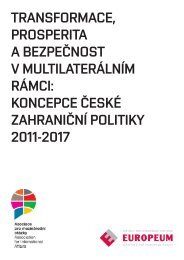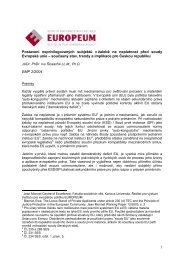eu constitutionalisation - EUROPEUM Institute for European Policy
eu constitutionalisation - EUROPEUM Institute for European Policy
eu constitutionalisation - EUROPEUM Institute for European Policy
You also want an ePaper? Increase the reach of your titles
YUMPU automatically turns print PDFs into web optimized ePapers that Google loves.
Chapter 6: A ‘saut constitutionnel’ out of an intergovernmental trap?<strong>Policy</strong> will probably not be replaced. Also, the institutional split betweenthe Council and the Commission in CFSP issues, which is planned tobe mitigated by a double-hatted Foreign Minister, will probably remain.Representing a central innovation of the constitutional treaty, it mightprove to be rather difficult to establish some <strong>for</strong>m of ‘Foreign Minister’ e.g.on the basis of inter-institutional agreements.⁷¹With regard to the further development of ESDP, the (continued) pragmaticimplementation of some elements of the TCE such as the <strong>European</strong>Defence Agency and the battle group concept could increase the Union’seffectiveness – also in case of the non-ratification of the TCE. However, thestrictly intergovernmental character of EU’s security and defence policy isnot expected to be changed in the near future.5.2. Towards a next step in the ratchet fusion?In view of this analysis and assessment, we expect that the living constitutionof the constitutional treaty will clearly manifest an ‘in-built’ need <strong>for</strong>further re<strong>for</strong>ms. The treaty would then document another step in a ratchetfusion process⁷². The provisions of the TCE would then not design the ultimateplateau; they are part of an evolution along “punctuated equilibria”⁷³.This chain of arguments would put the TCE chapters in a historical andtheoretical context: in each IGC the ‘masters of the treaty’ have regularlyrevised the legal constitution upwards on a ladder with ever refined modesof intergovernmental governance from soft to harder variations; comparedto other policy fields like EMU and policies in the field of justice and homeaffairs treaty changes with regard to CFSP (including the constitutionaltreaty) have not yet moved this policy field onto the supranational level.Visions and concepts have evolved though not towards a federal finalité.member states do keep a considerable domain reservée <strong>for</strong> their <strong>for</strong>eignand especially defence thinking. National actors are apparently not willingand/or able to follow the Monnet method of transferring real sovereignty,even if it is of a limited nature. This school of thought expects a recurrentpattern also <strong>for</strong> the future: a stable set of cooperation on a plateau provessuboptimal in a crisis of high politics. Faced with a clear output failure theChapter 6: A ‘saut constitutionnel’ out of an intergovernmental trap?EU states and especially the heads of government try to remedy this structuralweakness by upgrading the provisions <strong>for</strong> the rules of their regime,which are used more intensively on a higher plateau – but would fail againin the next external shock. None of this upgrading however transgressesa crucial threshold: the defence of national sovereignty prevents a boldconstitutional leap towards a more effective and efficient Union. In spiteof many ef<strong>for</strong>ts member states do not have enough energy to leave theintergovernmental trap.Imperfect as it is, CFSP and its younger relative, the ESDP, will thus remainof high relevance <strong>for</strong> both the political world and <strong>for</strong> the academic research.Even more than 30 years after its inception as <strong>European</strong> Political Cooperation(EPC) this set up has not reached its final stage, neither as a legal nor asa living constitution. Thus, both constitutional architects, as well as observersfrom the ivory tower will have considerable tasks still ahead.71) Though, in the current debate, there are also more optimistic views on this option, see <strong>for</strong> example KURPAS(2005).72) WESSELS (2001).73) HAY (2002), p. 161ff.226227








